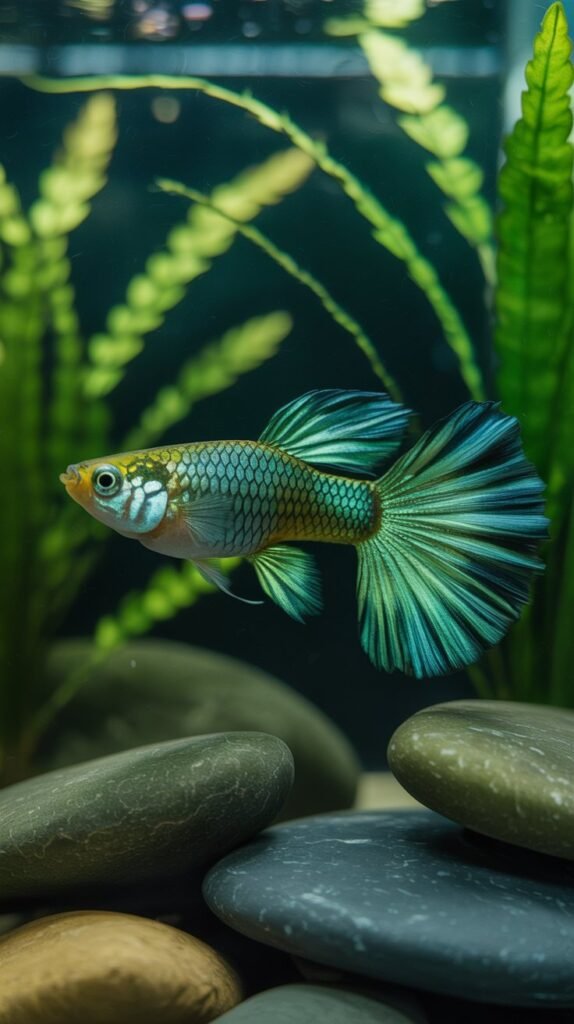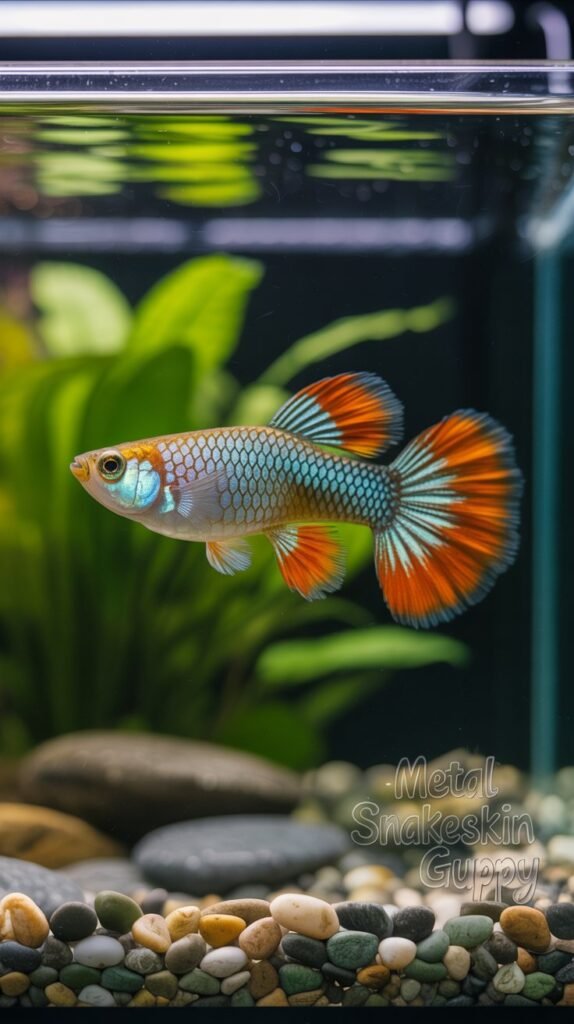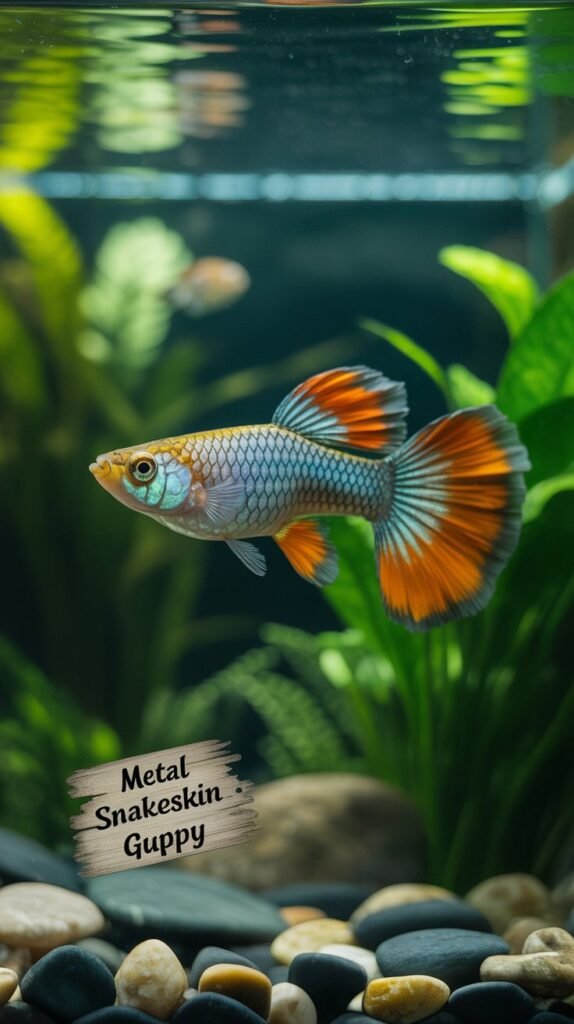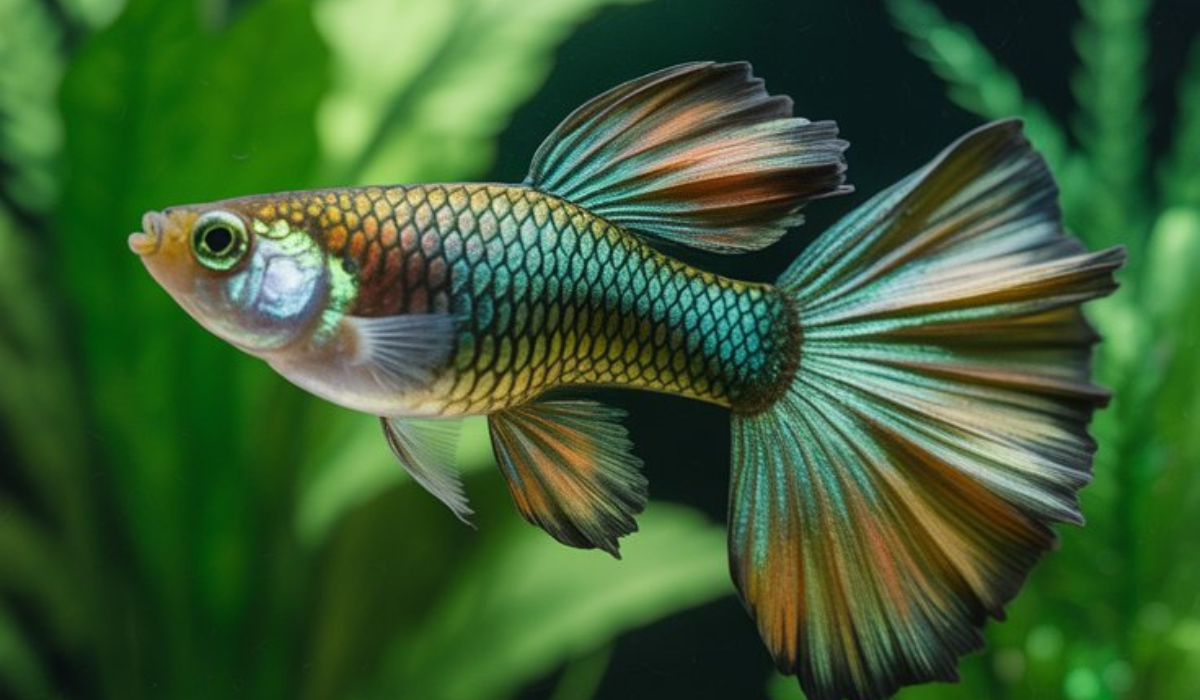The Metal Snakeskin Guppy is one of the most striking varieties in the guppy world, combining dazzling metallic coloration with intricate snakeskin patterns. Known for its shimmering scales and active nature, this guppy is a true showstopper for aquarists looking to add color and charm to their tanks.
In this guide, we’ll explore everything you need to know about the Metal Snakeskin Guppy — from its origin, characteristics, and tank setup to feeding, breeding, and health care. Whether you’re a beginner or an experienced fishkeeper, this comprehensive article will help you understand how to care for and enjoy these beautiful fish.
1. Introduction to Metal Snakeskin Guppy
The Metal Snakeskin Guppy (Poecilia reticulata) is a selectively bred strain known for its metallic sheen and snakeskin-like body pattern. These guppies are a hybrid of the Snakeskin Guppy and metallic color strains developed through generations of selective breeding.
Their scales exhibit a shimmering metal-like luster, often reflecting hues of gold, silver, green, or blue, combined with fine reticulated patterns resembling a snake’s skin. This unique combination gives them an almost futuristic look in any aquarium setting.
2. Origin and History

Guppies originate from the warm, freshwater rivers and streams of South America, primarily in Venezuela, Brazil, Trinidad, and Barbados. The Metal Snakeskin Guppy is a modern variant, developed through years of crossbreeding among guppy enthusiasts and breeders.
The goal was to combine the iridescent metallic coloration from “metal guppies” and the distinct snakeskin pattern from “snakeskin guppies.” The result is a visually stunning fish that has gained immense popularity in both Asian and Western aquarium markets.
3. Physical Appearance
The Metal Snakeskin Guppy is celebrated for its unique blend of pattern, color, and shine. Here’s what makes it stand out:
Body Pattern
The body is covered with intricate, net-like lines resembling a snake’s skin, which is how the “snakeskin” name originated. This pattern typically extends from the gills to the tail.
Coloration
Depending on the strain, the base color can be silver, golden, or bluish metallic. The metallic effect gives off a reflective sheen under aquarium lighting, making the fish appear luminous.
Tail Types
These guppies come in various tail shapes, including:
- Delta tail (triangular fan-shaped)
- Round tail
- Swordtail
- Ribbon tail
The tail often features vivid colors like red, orange, yellow, or blue, contrasting beautifully with the metallic body.
Size
- Males: 1.2 to 1.5 inches
- Females: 2 to 2.5 inches
4. Behavior and Temperament
Metal Snakeskin Guppies are peaceful, social, and active swimmers. They thrive best in groups and make excellent community fish.
They rarely show aggression, except for minor chasing behavior during mating. Because of their calm nature, they can be housed with other peaceful species such as:
- Neon Tetras
- Corydoras Catfish
- Mollies
- Platies
- Other Guppies
Avoid aggressive species like Barbs or Cichlids, which might nip their fins.
5. Ideal Tank Setup
Creating the right environment is essential for keeping your Metal Snakeskin Guppies healthy and vibrant.
Tank Size
- Minimum tank size: 10 gallons for small groups.
- For breeding or large colonies: 20–30 gallons recommended.
Water Conditions
| Parameter | Ideal Range |
|---|---|
| Temperature | 72°F – 82°F (22°C – 28°C) |
| pH Level | 6.8 – 7.8 |
| Hardness | 8–12 dGH |
| Ammonia/Nitrite | 0 ppm |
| Nitrate | <20 ppm |
Filtration
Use a gentle filter like a sponge or hang-on-back filter to maintain water quality without creating too much current. Guppies prefer calm water flow.
Lighting
Moderate lighting helps showcase their metallic scales. LED aquarium lights enhance their coloration beautifully.
Plants and Decorations
Live plants such as Java Moss, Hornwort, or Anubias provide hiding spots and help improve water quality. You can also add smooth gravel and driftwood to replicate their natural habitat.
6. Diet and Feeding
The Metal Snakeskin Guppy is an omnivore with a versatile diet. To keep them healthy and brightly colored, offer a balanced diet that includes both plant-based and protein-rich foods.
Recommended Foods
- High-quality flake food: For everyday nutrition
- Frozen or live food: Brine shrimp, daphnia, bloodworms
- Vegetables: Blanched spinach or zucchini (occasional)
- Micro pellets: For extra protein during breeding
Feed small amounts 2–3 times daily, ensuring they consume all food within 2 minutes. Overfeeding can lead to obesity and water pollution.
7. Breeding Metal Snakeskin Guppies

Guppies are known as livebearers, meaning they give birth to free-swimming fry instead of laying eggs. Breeding Metal Snakeskin Guppies is relatively easy, even for beginners.
Steps for Successful Breeding
- Set up a breeding tank (10–15 gallons) with dense plants and a sponge filter.
- Select healthy pairs with strong metallic and snakeskin traits.
- Maintain temperature at 78°F for faster breeding.
- Feed high-protein foods like bloodworms and brine shrimp to encourage spawning.
Gestation and Fry Care
- Female guppies give birth every 28–35 days.
- Each batch may include 20–60 fry depending on the female’s size and age.
- Move the female back to the main tank after birth to prevent her from eating the fry.
- Feed fry with infusoria, micro worms, or crushed flakes several times a day.
Selective breeding can enhance the metallic shine and pattern consistency in future generations.
8. Common Diseases and Prevention
Like all tropical fish, Metal Snakeskin Guppies are prone to certain diseases, especially in poor water conditions.
Common Diseases
- Ich (White Spot Disease) – White spots on the body and fins
- Fin Rot – Frayed fins caused by bacteria
- Velvet Disease – Golden dust-like coating on the skin
- Swim Bladder Disorder – Difficulty swimming or floating abnormally
Prevention Tips
- Maintain clean water with regular 20–30% water changes.
- Quarantine new fish before adding them to your main tank.
- Avoid overfeeding and overcrowding.
- Use aquarium salt (1 tsp per 5 gallons) to prevent mild infections.
9. Lifespan and Growth
With proper care, the Metal Snakeskin Guppy can live up to 2–3 years. Their lifespan can be extended through:
- Clean water conditions
- Balanced diet
- Stress-free environment
- Avoiding aggressive tank mates
Males typically develop full coloration by 8–10 weeks, while females grow slightly larger but remain less colorful.
10. Tank Mates Compatibility

Metal Snakeskin Guppies are ideal for community aquariums due to their peaceful disposition.
Compatible Tank Mates
- Neon Tetras
- Mollies
- Swordtails
- Rasboras
- Corydoras Catfish
- Cherry Shrimp
Avoid With
- Barbs
- Bettas
- Large Cichlids
- Fin-nipping species
Keeping them in peaceful communities ensures less stress and healthier, brighter fish.
11. Why Choose Metal Snakeskin Guppies?
Here’s why aquarium hobbyists love them:
- Visually stunning: Metallic body and snakeskin patterns
- Peaceful nature: Great for community tanks
- Active swimmers: Add liveliness to your aquarium
- Easy breeders: Perfect for beginners and hobbyists alike
- Low maintenance: Thrive in basic freshwater setups
Whether you’re looking to start a breeding project or simply want a vibrant display fish, the Metal Snakeskin Guppy is an excellent choice.
12. Tips for Enhancing Color and Health
To bring out the best metallic shine and maintain vibrant colors:
- Use LED lighting with full spectrum capability
- Provide spirulina-based flakes to enhance pigment
- Keep stable water parameters
- Include natural sunlight exposure (limited and indirect)
- Avoid inbreeding to maintain genetic diversity
Healthy guppies display intense colors, strong swimming activity, and clear fins.
13. Cost and Availability
The Metal Snakeskin Guppy is moderately priced, depending on its pattern, coloration, and fin type.
- Average price: $3 to $10 per fish
- Rare strains: Up to $20 each
They are widely available in local pet stores, online marketplaces, and specialized guppy breeders worldwide.
14. Conclusion
The Metal Snakeskin Guppy is a perfect blend of beauty, elegance, and simplicity. With its shimmering metallic body and intricate snakeskin design, this guppy variety can elevate the aesthetic appeal of any aquarium.
They are easy to care for, peaceful in temperament, and rewarding to breed — making them suitable for both beginners and advanced aquarists. By maintaining ideal tank conditions, offering a nutritious diet, and avoiding stress, you can enjoy these captivating fish for years to come.
FAQs About Metal Snakeskin Guppy
1. What is a Metal Snakeskin Guppy?
A Metal Snakeskin Guppy is a selectively bred guppy strain with metallic body coloration and a snakeskin-like pattern across its body and tail.
2. Are Metal Snakeskin Guppies good for beginners?
Yes! They are hardy, adaptable, and easy to breed, making them perfect for beginners.
3. How long do Metal Snakeskin Guppies live?
They typically live between 2 to 3 years, depending on care quality and water conditions.
4. What should I feed my Metal Snakeskin Guppy?
Feed them high-quality flake food, live or frozen food (like brine shrimp), and occasional vegetables.
5. Can Metal Snakeskin Guppies live with other fish?
Yes, they coexist peacefully with most small, non-aggressive fish such as tetras, mollies, and platies.
6. How can I enhance their metallic coloration?
Provide a balanced diet, good lighting, and clean water. Adding spirulina or color-enhancing foods helps too.
7. Do they need a heater?
Yes, guppies prefer warm water, ideally between 75°F and 82°F.
8. How often should I clean the tank?
Perform 20–30% water changes weekly and clean the substrate regularly to maintain water quality.
9. Can I breed Metal Snakeskin Guppies easily?
Absolutely! They breed readily, and females can produce fry every month.
10. What size tank is best for them?
A 10-gallon tank is suitable for a small group, but larger tanks allow more space for swimming and breeding.

